Discover the ultimate photographer's paradise with our guide to the Top 10 Destinations in Bhutan for a Photography Tour. From the iconic Tiger's Nest Monastery perched atop the cliffs of Paro Valley to the serene landscapes of the Phobjikha Valley, Bhutan offers a myriad of breathtaking locations for photography enthusiasts. Explore the rich tapestry of Thimphu’s architecture, the spiritual depth of Bumthang Valley, and the untouched beauty of Haa Valley. Capture the majestic dzongs of Punakha and Trongsa, and witness the unique wildlife of Jigme Dorji National Park. Whether you're capturing vibrant cultural ceremonies or tranquil high-altitude landscapes, Bhutan’s diverse scenery provides endless opportunities for stunning photography. Join us as we delve into the best spots across this mystical kingdom with Amen Bhutan Tours and Treks, ensuring every snapshot you take is a treasure trove of memories.
Paro Valley
Paro Valley is one of Bhutan's most picturesque regions, renowned for its robust cultural heritage and breathtaking landscapes. Nestled in the heart of Bhutan, this valley is a prime destination for photographers due to its scenic vistas and significant historical sites.
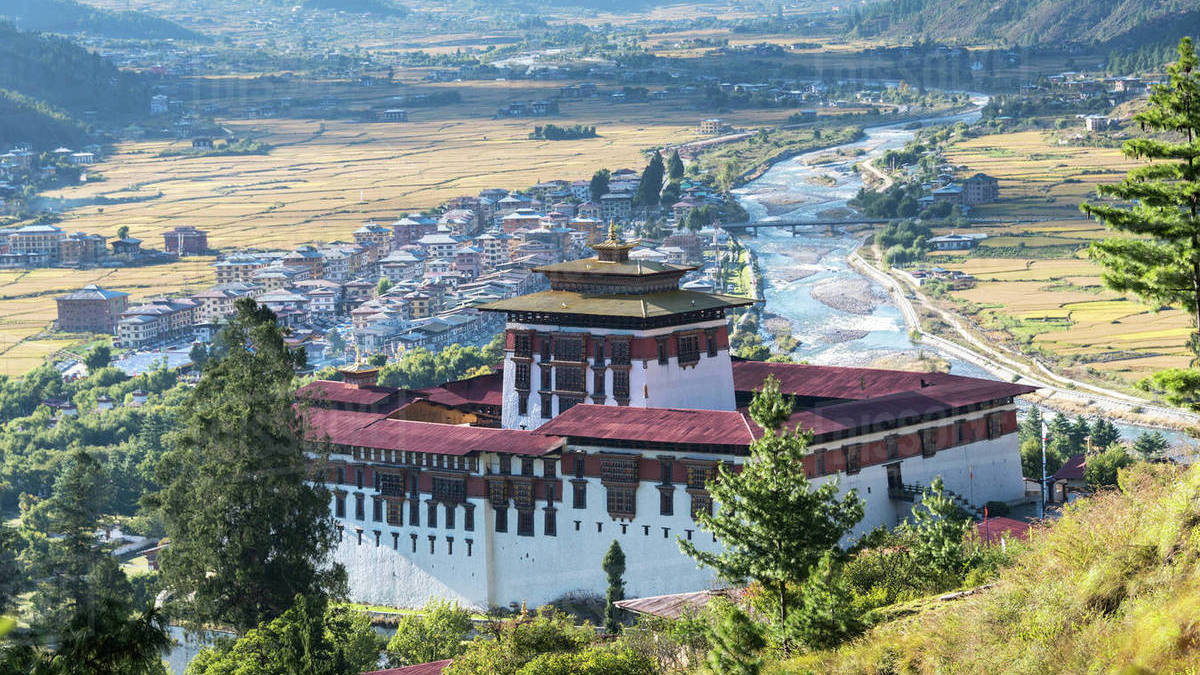
Key Highlights of Paro Valley
- Tiger's Nest Monastery (Paro Taktsang): This iconic monastery, perched precariously on a cliff about 900 meters above the Paro valley, is arguably the most photographed site in Bhutan. The monastery's stunning location and the surrounding majestic mountains make it a spectacular subject for photography.
- Rinpung Dzong: Known as the Fortress on a Heap of Jewels, Rinpung Dzong serves as a fine example of Bhutanese architecture and offers photographers a chance to capture the essence of Bhutanese dzong architecture. The annual Paro Tshechu, held here, is a colorful festival that provides unique cultural photography opportunities.
- Paro’s Main Street: Lined with traditional wooden structures and small shops, the main street of Paro is ideal for street photography and offers a glimpse into the daily lives of the local people.
- National Museum of Bhutan: Housed in a former watchtower above the Rinpung Dzong, this museum provides a panoramic view of the Paro valley, ideal for landscape shots, and is home to fascinating artifacts that tell the story of Bhutan’s history.
- Archery Grounds: As the national sport, archery plays a significant role in Bhutanese culture. Visiting the archery grounds in Paro allows photographers to capture the dynamic action of archery competitions and the vibrant interactions among competitors and spectators.
- Drukgyel Dzong Ruins: These ruins tell the story of a fortress that once withstood invasions from Tibet. The scenic backdrop of the snow-capped Mount Jomolhari enhances the historical allure, making it a compelling site for photographers.
- Chele La Pass: At an altitude of about 3,988 meters, this is one of the highest motorable passes in Bhutan, offering stunning panoramic views of the surrounding mountains and valleys. It's especially beautiful when the rhododendron forests bloom in vivid colors.
- Kyichu Lhakhang: One of the oldest and most sacred temples in Bhutan, dating back to the 7th century, Kyichu Lhakhang is a testament to the spiritual and architectural heritage of Bhutan, surrounded by tranquil gardens that are perfect for contemplative photography.
Photography Tips for Paro Valley
- Best Time to Visit: The best times for photography in Paro are during the spring (March to May) when the landscapes are lush and vibrant, and in the autumn (September to November) when the skies are clear and the views of the Himalayan peaks are unobstructed.
- Gear Considerations: Given the variety of photographic opportunities, from landscapes to cultural events, a versatile lens kit is recommended. A wide-angle lens is great for architectural and landscape shots, while a telephoto lens can be useful for capturing details during festivals or wildlife in the area.
- Cultural Sensitivity: When photographing local people, especially during religious ceremonies or in temples, always ask for permission. Be respectful of the cultural norms and practices to ensure a positive experience both for you and for your subjects.
Paro Valley not only offers a rich tapestry of photographic subjects but also provides an immersive experience into the culture and traditions of Bhutan. Whether you're a seasoned photographer or an enthusiastic amateur, Paro promises a rewarding photographic expedition.
Thimphu
Thimphu, the capital of Bhutan, uniquely blends modern development with ancient traditions, making it a fascinating destination for photographers looking to capture a variety of subjects from urban landscapes to traditional Bhutanese architecture.

Key Highlights of Thimphu
- Tashichho Dzong: This impressive fortress is not only the seat of Bhutan's government but also the summer residence of the monastic order's leader. The Dzong's grand architecture and the meticulously maintained gardens provide excellent photo opportunities, especially during the golden hour when the light accentuates its features.
- Buddha Dordenma Statue: Standing at 51 meters tall, this massive statue of Buddha overlooks the Thimphu Valley from atop a hill in Kuenselphodrang Nature Park. The statue and its panoramic views of the valley make for dramatic landscape and architectural shots.
- National Memorial Chorten: This stupa, built in memory of the third King of Bhutan, is a focus of daily religious life in Thimphu. Photographers can capture the devout Bhutanese circling the Chorten and spinning prayer wheels in a serene display of faith and tradition.
- Thimphu’s Weekend Market: The vibrant weekend market is a hub of activity where locals come to buy and sell goods. It's an excellent place for candid photography, capturing the essence of Bhutanese daily life, and the colorful array of fresh produce and traditional clothing.
- Folk Heritage Museum: Housed in a traditional three-story Bhutanese house, this museum offers insight into the Bhutanese way of life. The rustic architecture and the displays of everyday household objects provide a backdrop for photos that tell a story of Bhutan's culture and history.
- Motithang Takin Preserve: This wildlife reserve is home to the Takin, Bhutan’s national animal. The preserve's natural setting and its unique inhabitants make it a great spot for wildlife photography within the capital’s limits.
- Thimphu Textile Museum: For those interested in arts and crafts, the Textile Museum offers a chance to photograph Bhutanese textiles, renowned for their intricate designs and vibrant colors. The museum not only displays these beautiful fabrics but also often features weavers demonstrating their craft.
- Simtokha Dzong: As the oldest fortress of its kind in Bhutan, Simtokha Dzong offers architectural photography with a historical angle. Its detailed wood carvings and ancient murals are particularly photogenic.
Photography Tips for Thimphu
- Best Time to Visit: The clear skies of autumn (September to November) provide excellent lighting for photography in Thimphu, though spring (March to May) is also picturesque with blooming flowers and vibrant green landscapes.
- Gear Considerations: A range of lenses can be beneficial in Thimphu. A wide-angle lens will capture the grandeur of dzongs and landscapes, while a prime lens is ideal for detailed shots in the market or museum.
- Cultural Sensitivity: When photographing people, especially in religious settings like the National Memorial Chorten, it’s important to be discreet and respectful. Always ask for permission before taking close-up photos of individuals.
Thimphu is a city that offers both urban and cultural photographic experiences, set against the backdrop of the majestic Himalayas. Its mix of ancient tradition and modernity makes it a compelling destination for photographers eager to explore and document the heart of Bhutan.
Punakha
Punakha, the ancient capital of Bhutan, is a treasure trove for photographers with its rich history, serene landscapes, and stunning architectural sites. Nestled in a lush valley where the Pho Chhu and Mo Chhu rivers meet, Punakha is renowned for its beautiful dzong and the vibrant local culture that surrounds it.
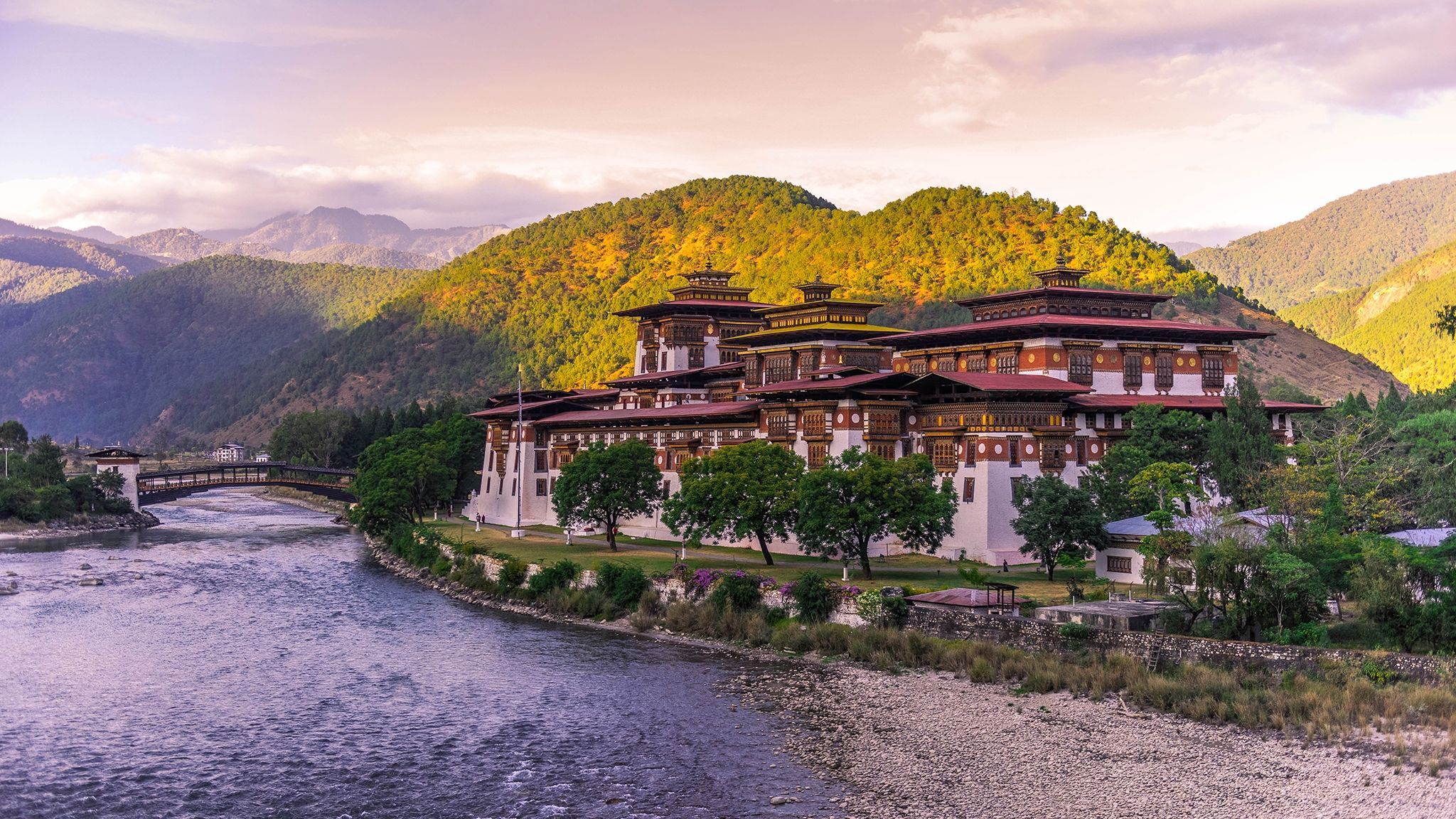
Key Highlights of Punakha
- Punakha Dzong: Often considered the most beautiful dzong in Bhutan, Punakha Dzong serves as a prime subject for photography with its striking location at the confluence of two rivers. The dzong is especially picturesque in spring when the lilac jacaranda trees surrounding it are in bloom.
- Suspension Bridge: Just nearby the Punakha Dzong, this is one of the longest suspension bridges in Bhutan, stretching across the Pho Chhu river. It offers dramatic views of the river and valley which are ideal for landscape and architectural photography.
- Khamsum Yulley Namgyal Chorten: A stunning monument built to promote peace and stability in the world, the chorten stands majestically on a hill above the valley. The hike to get there offers several scenic vistas, and the chorten itself, with its elaborate paintings and architecture, provides unique photo opportunities.
- Chimi Lhakhang: This fertility temple, located in the village of Sopsokha, is famous for its humorous and erotic art. The walk through the rice fields to reach the temple offers a pastoral setting that contrasts nicely with the spiritual and unique character of the temple itself.
- Mo Chhu River: Ideal for nature photography, the gentle Mo Chhu River flows through the valley, bordered by lush forests and agricultural fields. The natural beauty of this area is perfect for those looking to capture serene water scenes and the daily life of locals who frequent the river.
- Ritsha Village: Known as the 'Village of Rice', this traditional village provides insight into the rural life of Bhutanese farmers. The traditional architecture of the houses and the daily activities of the villagers make for compelling cultural photography.
Photography Tips for Punakha
- Best Time to Visit: The spring months (March to May) are ideal for photography in Punakha, especially when the jacarandas are blooming around the dzong. However, autumn (September to November) also provides clear skies and pleasant weather, perfect for capturing the golden hues of the landscape.
- Gear Considerations: A versatile zoom lens will be beneficial for capturing both the architectural grandeur of Punakha Dzong and the intimate details of the chortens and local life. A tripod can also be handy for early morning or late evening shots to manage low light conditions.
- Cultural Sensitivity: When photographing religious sites or ceremonies, it is important to maintain respect for the local customs. Always ask permission before taking photos, especially in smaller villages or less touristy areas.
Punakha is a captivating destination that blends natural beauty with profound cultural heritage, offering photographers endless opportunities to capture the essence of Bhutanese life and landscape. Whether it's architectural marvels, religious sites, or the simplicity of rural life, Punakha provides a rich canvas for photographers.
Phobjikha Valley
Phobjikha Valley, also known as Gangtey Valley, is a stunning glacial valley on the western slopes of the Black Mountains in central Bhutan, widely regarded for its scenic landscapes and rich biodiversity. This tranquil valley is a favorite among nature lovers and photographers for its expansive, gentle slopes and the rare wildlife it shelters.

Key Highlights of Phobjikha Valley
- Black-Necked Cranes: Phobjikha Valley is perhaps best known as the winter home of the black-necked cranes. These elegant birds migrate from the Tibetan Plateau to the valley every winter, providing a spectacular opportunity for wildlife photography.
- Gangtey Goenpa Monastery: Overlooking the entire valley, this important monastery of the Nyingma school of Buddhism offers stunning panoramic views and is a serene spot for capturing both architectural and spiritual elements.
- Nature Trails: The valley features several well-marked nature trails that meander through the landscape, offering diverse perspectives of the valley’s natural beauty. These trails are excellent for landscape photography, especially during the early morning or late afternoon when the light is most favorable.
- Wetlands and Wildlife: The valley floor, a protected area, includes wetlands that are rich in biodiversity. Aside from the cranes, photographers might capture images of other wildlife such as foxes, wild boars, and various species of birds.
- Cultural Experiences: The local community in Phobjikha is deeply rooted in tradition and customs. Visiting during local festivals, particularly the annual Black-Necked Crane Festival, offers unique cultural photography opportunities, showcasing traditional dances, costumes, and celebrations.
- Rural Life and Landscapes: The valley is dotted with quaint farmhouses and potato fields, set against a backdrop of rolling hills. This rural setting captures the essence of Bhutanese countryside life, ideal for those interested in pastoral scenes and agricultural landscapes.
Photography Tips for Phobjikha Valley
- Best Time to Visit: The best time for photographers to visit is from late October to early March, when the black-necked cranes are in residence. November, during the Black-Necked Crane Festival, is particularly vibrant.
- Gear Considerations: For wildlife photography, a telephoto lens (at least 200mm) is essential to capture detailed shots of the cranes and other animals without disturbing them. A wide-angle lens will help in capturing the vastness of the landscapes. Bringing a tripod can also aid in shooting stable, sharp images in varied lighting conditions.
- Respect Nature: Since Phobjikha is a protected area, it’s important to follow guidelines to ensure minimal impact on wildlife and the environment. Keeping a safe distance from animals and sticking to marked trails are practices that help preserve the natural habitat.
Phobjikha Valley offers a serene escape into nature, with its wide-open landscapes and remarkable wildlife providing endless inspiration for photographers. Its combination of natural beauty and cultural richness makes it an unmissable destination for anyone looking to explore and photograph Bhutan’s pristine environments.
Bumthang Valley
Bumthang Valley is often described as the spiritual heartland of Bhutan, boasting some of the oldest temples and monasteries in the country. This region comprises four main valleys: Chokhor, Tang, Ura, and Chhume, each with its distinct charm and historical significance. Bumthang's serene landscapes, dotted with sacred sites and enveloped in rich historical lore, make it a captivating destination for photographers and spiritual seekers alike.
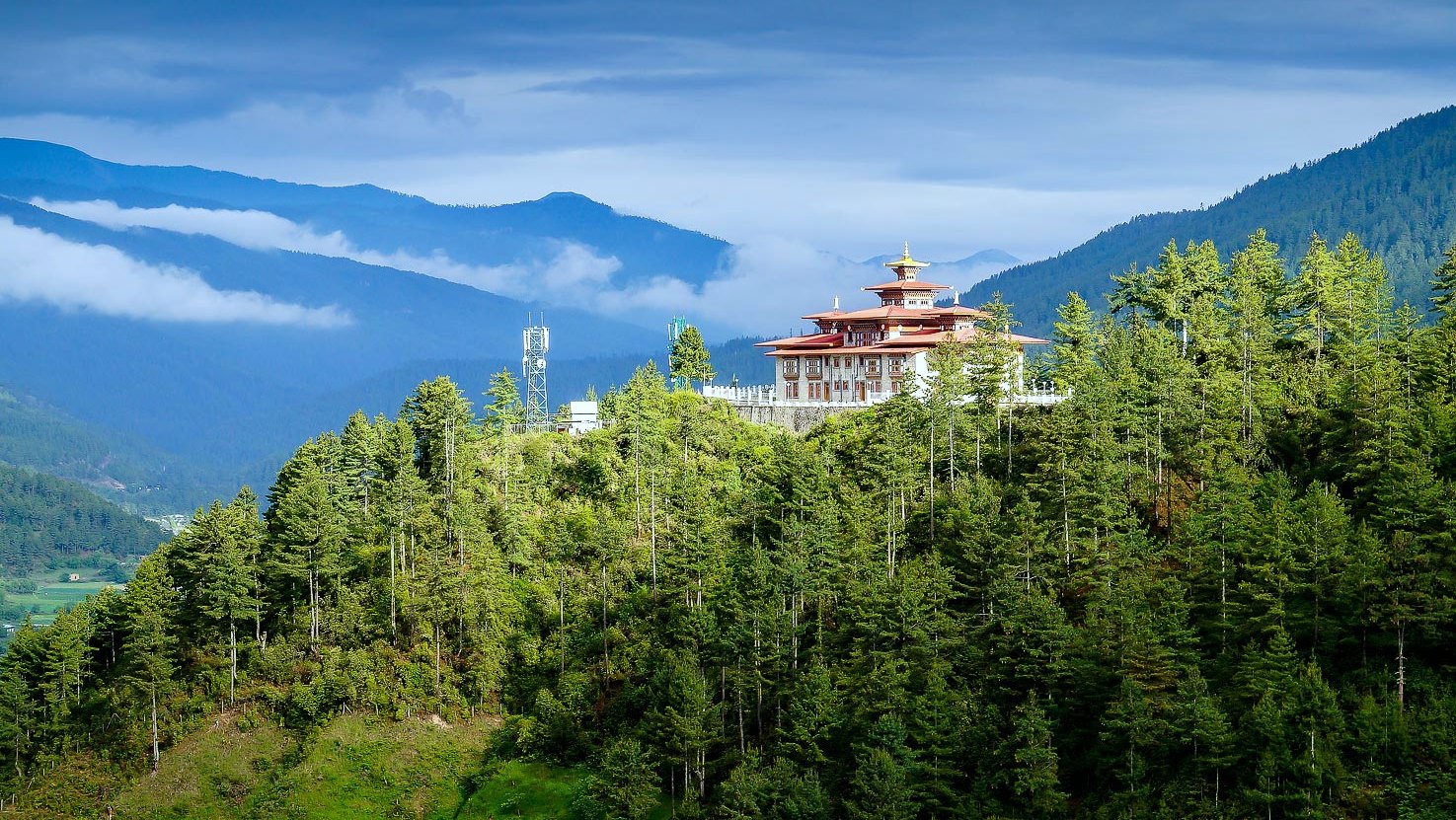
Key Highlights of Bumthang Valley
- Jambay Lhakhang: One of the oldest temples in Bhutan, dating back to the 7th century, Jambay Lhakhang is a key religious site that hosts the famous Jambay Lhakhang Drup festival, featuring the spectacular 'Mewang' (Fire Ceremony) and 'Tercham' (Dance of the Treasure). Capturing these events can offer unique insights into Bhutanese spiritual life.
- Kurje Lhakhang: This significant monastery consists of three temples, with the oldest dating back to the 17th century. It's said to be where Guru Rinpoche left his body imprint. The complex is set against a backdrop of cliffside and offers stunning photographic opportunities of religious iconography and architectural detail.
- Tamshing Lhakhang: Founded in the 16th century by Pema Lingpa, a famous Bhutanese saint, Tamshing Lhakhang is known for its ancient wall paintings and intricate wood carvings. Photographers will find the interior artwork and the festive atmosphere during local celebrations particularly compelling.
- Thangbi Mani Festival: Held in the Thangbi Lhakhang in the Choekhor Valley, this festival is a colorful celebration of local culture, with masked dances and religious performances. It provides excellent opportunities for capturing the vibrant cultural heritage of the region.
- The Swiss Farm: Surprisingly, Bumthang is also known for its Swiss influences, including cheese production. The Swiss Farm adds a unique aspect to Bumthang’s photography portfolio, offering shots of cheese making, breweries, and the beautiful farm landscapes.
- Burning Lake (Membartsho): This sacred site in the Tang Valley is where Pema Lingpa discovered several of Guru Rinpoche's hidden treasures. The lake and its surroundings provide a mystical setting for photography, particularly with the colorful prayer flags and emerald waters.
Photography Tips for Bumthang Valley
- Best Time to Visit: Autumn (September to November) is ideal for visiting Bumthang, as the weather is clear and the annual festivals add vibrancy and cultural depth to your photographs. Spring (March to May) also provides pleasant weather and the natural landscape is in full bloom.
- Gear Considerations: A versatile camera setup with a standard zoom lens can cover most needs in Bumthang. A fast lens (f/2.8 or faster) is beneficial for indoor shots in the dimly lit monasteries and during festival performances. Carrying a tripod can help in low-light conditions and for capturing stable landscape shots.
- Cultural Sensitivity: When photographing religious sites and festivals, it’s crucial to respect local customs. Always seek permission before taking photos of religious objects or people. Be discreet and avoid using flash inside monasteries to preserve the sanctity of the site.
Bumthang Valley not only offers a feast for the lens with its stunning natural scenery and historical buildings but also provides a deep dive into the spiritual and cultural life of Bhutan. For photographers, the blend of nature, history, and spirituality in Bumthang makes it an enriching and rewarding destination to explore.
Haa Valley
Haa Valley remains one of Bhutan's most pristine and less traveled destinations, offering a tranquil escape into an area rich with cultural heritage and stunning natural beauty. Tucked away in the southwestern corner of Bhutan, this secluded valley is bordered by the district of Paro, Chhukha, and the Tibet Autonomous Region of China. Haa Valley's untouched landscapes and traditional lifestyle present a unique photography experience, capturing a side of Bhutan not seen in the more frequented tourist spots.
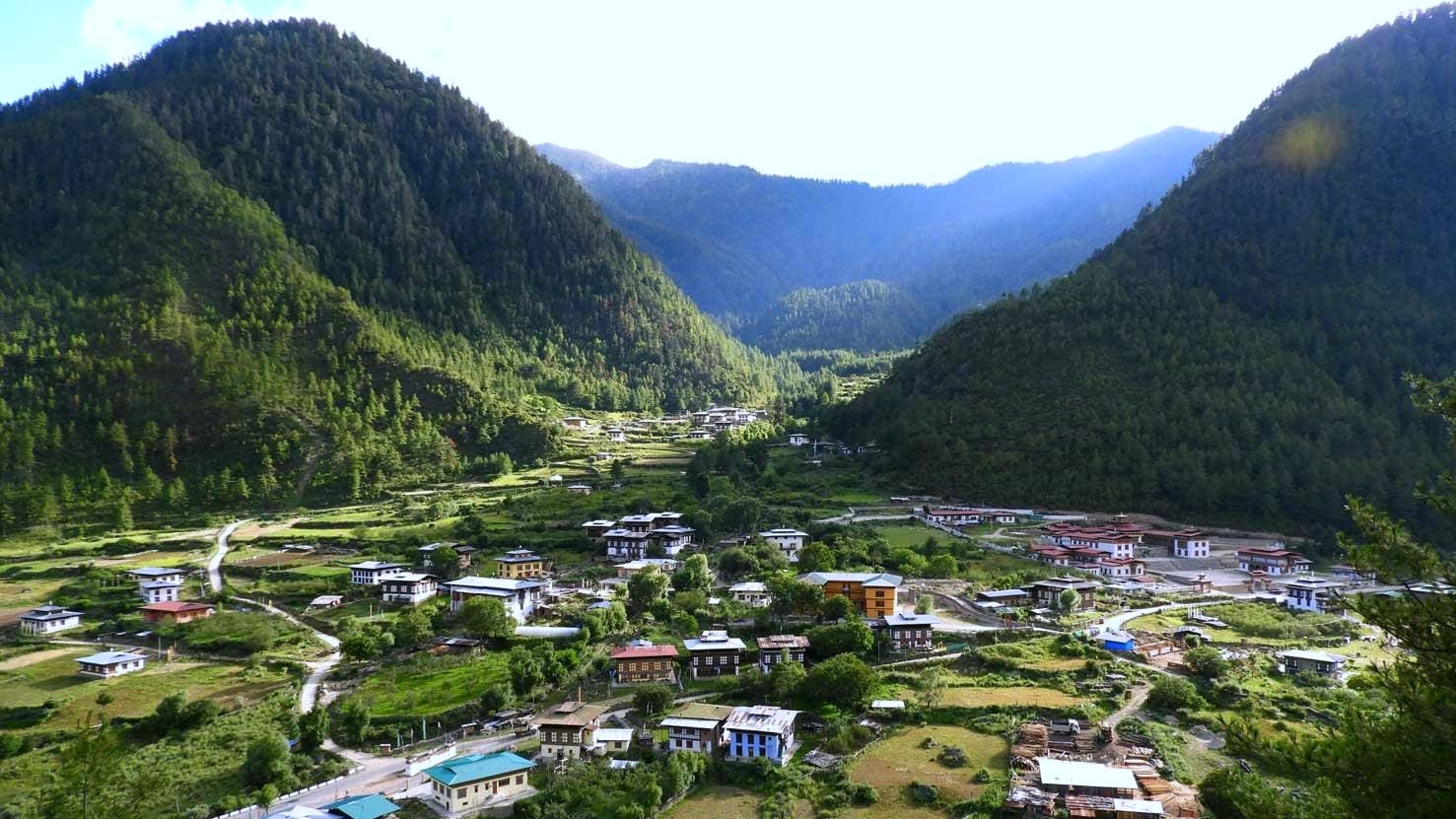
Key Highlights of Haa Valley
- Haa Town: The small and serene town of Haa provides a window into the lives of the local people. The town's traditional wooden houses and quiet streets lined with shops selling local handicrafts offer a glimpse into the authentic Bhutanese way of life.
- Lhakhang Karpo and Lhakhang Nagpo: These are two of the most significant and ancient temples in the valley, often referred to as the White and Black Temples respectively. Located close to each other, they provide wonderful subjects for architectural and spiritual photography.
- Annual Haa Summer Festival: If you visit during the summer, you can capture the vibrant Haa Summer Festival, which showcases traditional living-culture, sports, and religious performances. It's an excellent opportunity for vibrant and dynamic cultural photography.
- Alpine Forests and Rugged Mountains: The valley is surrounded by dense alpine forests and bordered by rugged mountain peaks. These landscapes are perfect for dramatic nature photography, especially during the morning when the light is soft and during the autumn when the foliage changes color.
- Tagchu Goemba: This 300-year-old monastery offers panoramic views of the Haa Valley. The monastery is set in a serene location, ideal for landscape photography with a cultural touch.
- Hiking and Trekking: For those looking to capture more remote scenes, Haa Valley offers numerous trekking routes that lead to breathtaking vistas and secluded areas. These treks are perfect for capturing untouched natural landscapes and the traditional nomadic lifestyle of the highlanders.
Photography Tips for Haa Valley
- Best Time to Visit: Autumn (September to November) is a fantastic time for photographers due to the clear skies and the vibrant fall colors. However, visiting during the Haa Summer Festival in July will also provide colorful and culturally rich photo opportunities.
- Gear Considerations: A variety of lenses will serve you well in Haa Valley. A wide-angle lens is ideal for landscape shots, while a telephoto lens can help capture distant peaks and wildlife. A lightweight tripod will be beneficial for long exposures and stable shots in varied terrain.
- Cultural Sensitivity: The valley's residents may be more conservative and less accustomed to tourists compared to those in more frequently visited areas. Always ask for permission before photographing local people or entering sacred sites. Showing respect and interest in their culture can also lead to more meaningful interactions and photo opportunities.
Haa Valley's combination of natural beauty, traditional lifestyle, and cultural richness makes it an ideal destination for photographers looking to explore and capture the essence of a less disturbed Bhutan. Whether you're interested in landscape, cultural, or architectural photography, Haa Valley offers a plethora of subjects in one of the most beautiful settings in the country.
Trongsa
Trongsa is a town steeped in history and rich in architectural marvels, situated in the central region of Bhutan. It is famously known for its strategic location and the impressive Trongsa Dzong, which historically controlled the east-west trade and helped consolidate the kingdom's unification. The panoramic views and the layers of history make Trongsa a captivating subject for photographers seeking to capture the essence of Bhutan’s royal heritage and stunning landscapes.

Key Highlights of Trongsa
- Trongsa Dzong: This massive fortress is the largest dzong in Bhutan and a key architectural highlight. Positioned on a ridge overlooking the gorge of the Mangde River, it offers dramatic vistas that are perfect for photography, especially during sunrise or sunset when the light accentuates its grandeur.
- Ta Dzong: This watchtower, which once guarded Trongsa Dzong, has been converted into a museum dedicated to the Wangchuck dynasty. The museum provides insights into the region's history and offers panoramic views of the surrounding valleys and the dzong itself, making it a prime spot for capturing both cultural artifacts and landscapes.
- Thruepang Palace: The winter palace of the second king, Jigme Wangchuck, adds a royal dimension to Trongsa’s attractions. Although less frequented, the palace’s architecture and historical significance provide unique photography opportunities.
- Chendebji Chorten: Modeled after Kathmandu’s Swayambhunath Stupa, this chorten lies en route to Trongsa and is surrounded by picturesque scenery. It’s an excellent spot for photographers looking to combine architectural elements with natural backdrops.
- Nabji Korphu Trek: For those interested in more adventurous photography, this trek around Trongsa offers lush landscapes, traditional villages, and wildlife encounters, providing a more in-depth look at the natural and cultural richness of central Bhutan.
- Local Festivals: Trongsa also hosts vibrant local festivals such as the Trongsa Tshechu. These festivals are filled with colorful dances, traditional music, and elaborate costumes, providing dynamic subjects for cultural photography.
Photography Tips for Trongsa
- Best Time to Visit: The winter months (December to February) offer clear skies and excellent visibility, ideal for landscape photography. However, if you wish to capture the vibrancy of local festivals, plan your visit during the annual Trongsa Tshechu, usually held in December or January.
- Gear Considerations: A versatile lens kit is advisable. Wide-angle lenses can capture the vastness of the landscapes and the architectural grandeur of the dzongs, while a telephoto lens is great for festival details and distant natural features. A tripod will help in low light conditions and for long exposures.
- Cultural Sensitivity: As with other parts of Bhutan, it's important to show respect when photographing religious sites and local people. Always ask for permission before taking close-up shots, especially during religious ceremonies.
Trongsa not only offers a journey through the annals of Bhutanese royal history but also provides endless visual inspiration with its majestic dzong, historical artifacts, and breathtaking landscapes. It is a must-visit destination for photographers interested in capturing the depth and diversity of Bhutan's cultural heritage and natural beauty.
Laya Village
Laya Village is one of the most remote and scenic high-altitude settlements in Bhutan, nestled at an elevation of over 3,800 meters (12,500 feet) in the Himalayan mountains. This unique village is not only known for its breathtaking landscapes but also for its distinct culture, traditional attire, and the semi-nomadic lifestyle of its inhabitants, the Layaps.
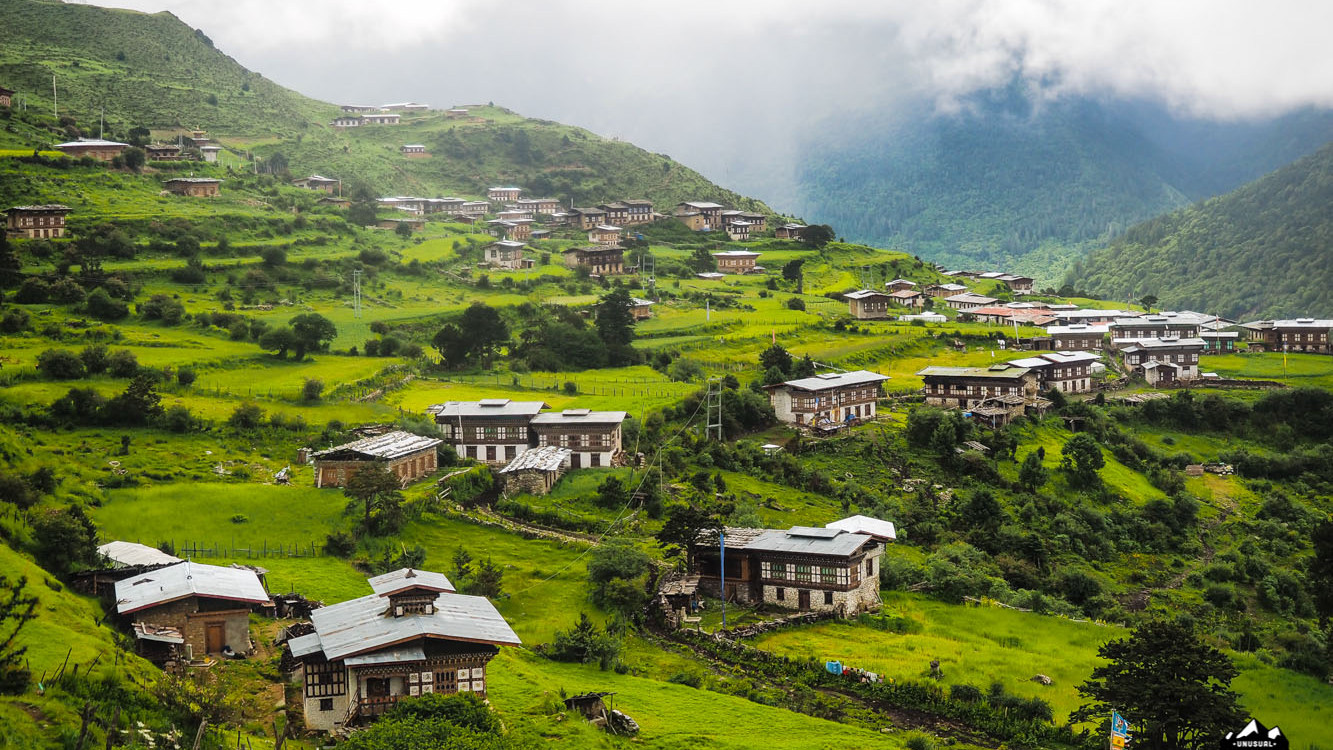
Key Highlights of Laya Village
- Remote and Unique Culture: Laya Village is famed for its residents' unique attire, especially the women who wear conical bamboo hats. The village's culture, festivals, and daily life provide rich photographic opportunities that capture a way of life that has remained largely unchanged for centuries.
- Laya Lhakhang: The spiritual center of the village, Laya Lhakhang, is a quaint and picturesque monastery that offers insight into the spiritual life of the Layaps. The monastery is a focal point during local festivals and provides a serene backdrop for photography.
- Stunning Natural Scenery: The village is surrounded by pristine alpine forests and high mountain peaks, including the famous Masagang mountain. The trek to Laya offers panoramic views of the rugged terrain, providing spectacular opportunities for landscape photography.
- Royal Highlander Festival: This festival celebrates the unique culture and traditions of the highland communities, including the Layaps. It features horse racing, yak beauty contests, and other traditional sports, alongside showcasing local music, dance, and crafts, making it a vibrant event for photographers.
- Wildlife and Flora: The route to Laya and the surrounding areas are known for their rich biodiversity, including the elusive snow leopard, takins, and blue sheep. The area is also a haven for botanists and nature photographers, with its diverse array of high-altitude plants and flowers.
- Adventure and Trekking: Reaching Laya Village involves a challenging trek through some of Bhutan’s most stunning and untouched landscapes. This journey itself is filled with opportunities to document remote trails, river crossings, and the breathtaking beauty of the Himalayas.
Photography Tips for Laya Village
- Best Time to Visit: The best times to visit Laya are during the spring (April to June) and autumn (September to November) when the weather is clearer and the paths are more accessible. The Royal Highlander Festival, usually held in October, is particularly photogenic.
- Gear Considerations: Due to the remote nature of Laya, it's essential to pack light but effectively. A durable, weather-resistant camera, a good range of lenses (wide-angle for landscapes and a telephoto for wildlife), and extra batteries are crucial, as charging facilities may be limited.
- Cultural Sensitivity: Given the village’s remote and traditional lifestyle, it’s particularly important to approach photography with respect and sensitivity. Always ask for permission before taking photos of the villagers, particularly during personal or intimate moments. Showing respect and interest can lead to more meaningful interactions and even invitations to photograph private aspects of their lives.
Laya Village offers a rare glimpse into the life of one of Bhutan’s most remote communities, set against the dramatic backdrop of the Himalayas. For photographers, the journey to Laya is as rewarding as the destination itself, filled with unparalleled scenic beauty and cultural richness.
Jigme Dorji National Park
Jigme Dorji National Park, named after the late King Jigme Dorji Wangchuck, is one of the largest and most significant protected areas in Bhutan. Spanning over an area that includes some of the most diverse ecological zones in the kingdom, the park is a sanctuary for a plethora of wildlife including many endangered species, and it offers stunning landscapes that range from subtropical forests to icy mountain peaks.
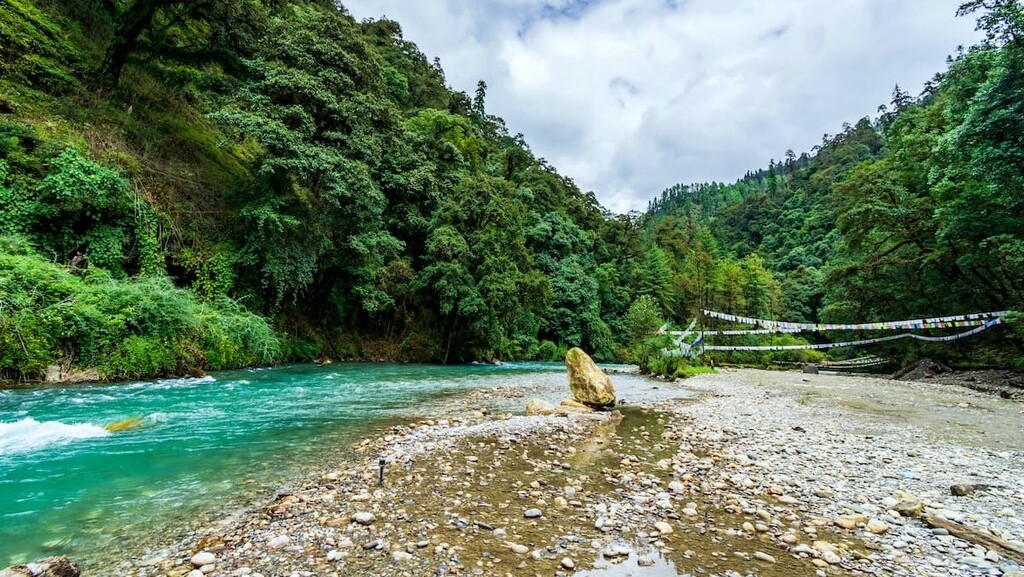
Key Highlights of Jigme Dorji National Park
- Diverse Wildlife: The park is home to many endangered species such as the snow leopard, Bengal tiger, and the Bhutan takin. It's also one of the only places in the world where the Royal Bengal tiger and the snow leopard habitats overlap. Wildlife photography here can be exceptionally rewarding.
- Mount Jomolhari: This majestic peak, revered as a sacred mountain, is a prominent feature within the park. Treks to the base camp of Mount Jomolhari offer spectacular views and are a favorite among photographers looking to capture the raw beauty of Bhutan’s high-altitude landscapes.
- Gasa Hot Springs: Located near the northern boundary of the park, these natural hot springs are a popular trekking destination. The springs are reputed for their medicinal properties and provide a serene setting for both relaxation and photography.
- Lingshi Dzong: This historic dzong, located within the park, offers a glimpse into the region's rich history and is an excellent example of medieval Bhutanese architecture. Its remote location provides a picturesque backdrop of untouched wilderness.
- Glacial Lakes: The park contains several stunning glacial lakes, including Thorthormi, Laya, and Lunana, which are some of the highest in the world. These lakes, along with the glacial landscapes around them, are incredibly scenic and offer unique photographic opportunities.
- Flora and Fauna: In addition to large mammals, the park is rich in avian species, making it a paradise for bird watchers. The varied altitude also supports a diverse range of plant life, from lush forests in the lower regions to alpine meadows higher up.
Photography Tips for Jigme Dorji National Park
- Best Time to Visit: The best times for wildlife and landscape photography in the park are during the spring (April to June) when the flowers bloom and the fall (September to November) when the skies are clear and the views are unobstructed. Wildlife is more visible during these times as well.
- Gear Considerations: A long telephoto lens (at least 300mm) is crucial for wildlife photography to capture detailed images from a safe distance. A wide-angle lens will help capture the vast landscapes. Due to the variable weather and rough terrain, weather-sealed gear is recommended.
- Preparation and Permissions: Given the park's remote and protected status, proper permits are required for entry. It’s also advisable to go with a guide who knows the area well and can assist in spotting wildlife and navigating the park’s vast terrain.
- Environmental Consciousness: As a visitor to a national park, maintaining environmental integrity should be a priority. Stick to designated trails, avoid disturbing wildlife, and carry out all trash.
Jigme Dorji National Park is not just a haven for wildlife enthusiasts but also a spectacular venue for photographers eager to capture the essence of Bhutan's natural heritage. Its remote beauty and ecological diversity make it an unforgettable destination for anyone looking to explore and photograph the wilder side of Bhutan.
Wangdue Phodrang
Wangdue Phodrang is one of the major towns and administrative centers of Bhutan, known for its rich cultural heritage and diverse ecological landscapes that range from subtropical plains in the south to cool, windy valleys in the central regions and icy peaks in the north. This district provides a unique blend of historical and natural sites, making it an intriguing destination for photographers and cultural enthusiasts alike.

Key Highlights of Wangdue Phodrang
- Wangdue Phodrang Dzong: Perched on a ridge overlooking the convergence of the Punakha Chhu and Dang Chhu rivers, the Wangdue Phodrang Dzong is an imposing structure with significant historical importance in Bhutanese administration and religion. Its strategic location and architectural grandeur offer fantastic opportunities for photography, particularly during the dzong’s restoration completion and reopening.
- Phobjikha Valley: Part of Wangdue Phodrang district, this glacial valley is famous as the winter home of the black-necked cranes. The valley's wide, beautiful landscapes and the cultural practices surrounding the crane conservation provide ample photographic subjects, from wildlife to panoramic landscapes.
- Gangtey Monastery: Located in the Phobjikha Valley, this 17th-century monastery is an important center of the Nyingmapa school of Buddhism. The monastery's stunning setting and architectural beauty make it a compelling subject for photographers, especially during the annual Gangtey Tshechu festival.
- Rinchengang Village: Opposite the Wangdue Phodrang Dzong, this ancient village is known for its closely packed traditional houses and skilled stonemasons. The unique layout and cultural vibrancy of the village offer a deep dive into the traditional lifestyle of Bhutanese villagers.
- Adha and Rukha Villages: These remote villages provide a glimpse into the pastoral life of the semi-nomadic people of central Bhutan. The traditional practices and the rustic environment are ideal for capturing the essence of Bhutan’s rural life.
- Rafting and Kayaking: For adventure seekers, the rivers around Wangdue Phodrang offer thrilling opportunities for white-water rafting and kayaking. These activities not only provide an adrenaline rush but also unique angles and perspectives for dynamic water-sport photography.
Photography Tips for Wangdue Phodrang
- Best Time to Visit: The autumn months (September to November) are ideal for visiting Wangdue Phodrang, offering clear skies and the best visibility for photography. Winter (December to February) is also a great time, especially for capturing the migratory black-necked cranes in the Phobjikha Valley.
- Gear Considerations: A versatile lens setup is recommended, including a wide-angle lens for landscapes and architectural shots, and a telephoto lens for wildlife and distant details. Given the region's varied terrain and climatic conditions, carrying weather-protected gear and a sturdy tripod can help in capturing sharper images under different conditions.
- Cultural Sensitivity: When photographing local communities or during festivals, it’s important to be respectful and considerate. Engaging with local guides not only enriches the experience but also ensures that interactions with villagers and participation in local customs are conducted with sensitivity and respect.
Wangdue Phodrang offers a photographer a rich tapestry of subjects, from majestic architectural sites and serene landscapes to vibrant cultural festivals and intimate portraits of rural life. Its diverse attractions encapsulate the essence of Bhutan’s cultural and natural heritage, making it a must-visit destination for photographers exploring Bhutan.
Explore Bhutan's top photography destinations with Amen Bhutan Tours and Treks! From the breathtaking Tiger's Nest in Paro to the remote beauty of Laya Village, each spot offers unique opportunities to capture the essence of Bhutan's natural landscapes and rich cultural heritage. Whether you're shooting the architectural wonders of Punakha Dzong or the vibrant festivals of Thimphu, Bhutan provides a diverse palette for photographers of all levels. Join us to capture the spirit and splendor of the Himalayan kingdom through your lens.
FAQs on Top 10 Destinations in Bhutan for Photography Tour
Q: What is the best time of year to go on a photography tour in Bhutan?
A: The best times for photography in Bhutan are during the spring (March to May) and autumn (September to November). These seasons offer clear skies, moderate weather, and vibrant natural landscapes. Autumn is particularly good for clear views of the Himalayas.
Q: Do I need special permits for photography in Bhutan?
A: Yes, while your entry visa will cover most areas, some specific sites, especially monasteries and dzongs, may require additional permits. Your tour operator, like Amen Bhutan Tours and Treks, can arrange these for you.
Q: What type of camera gear should I bring for a photography tour in Bhutan?
A: A versatile camera setup is recommended. This includes a wide-angle lens for landscapes, a telephoto lens for wildlife and distant details, and possibly a fast prime lens for low-light conditions. Also, consider bringing extra batteries and memory cards.
Q: Are there cultural considerations I should be aware of when photographing in Bhutan?
A: Yes, always ask for permission before photographing people, especially in religious settings. Be respectful of local customs and dress modestly when visiting sacred sites.
Q: Can I use a drone for photography in Bhutan?
A: Drone usage in Bhutan is restricted and requires special permission from the Bhutan Civil Aviation Authority. It is rarely granted to tourists due to privacy and security concerns.
Q: What kind of clothing should I pack for a photography tour in Bhutan?
A: Pack layers to accommodate varying temperatures, especially if visiting both lowland and highland areas. Include warm clothing for early morning shoots, particularly in higher altitudes like Laya Village.
Q: How physically demanding are photography tours in Bhutan?
A: This can vary significantly depending on the tour. Some locations like Tiger’s Nest and remote villages involve hikes and can be physically demanding. Check the itinerary and ensure you are comfortable with the level of activity.
Q: What are the must-visit spots for nature photography in Bhutan?
A: Phobjikha Valley for landscapes and bird watching, Jigme Dorji National Park for wildlife, and the high-altitude lakes and peaks around Laya for dramatic natural scenery.
Q: Can I participate in local festivals for photography?
A: Yes, festivals are a highlight for photographers. The Thimphu Tshechu and the Paro Tshechu are particularly photogenic with their colorful dances and large gatherings.
Q: How can I ensure my photography respects Bhutanese culture?
A: Engage with locals respectfully, understand the significance of sites and rituals, and use your photography to tell stories that respect and honor Bhutanese traditions.
If you are looking for tour packages in Bhutan please click here
If you need any further information, please contact us, Email: at [email protected] , Phone (Whatsapp or Viber) +975-1755-6636
